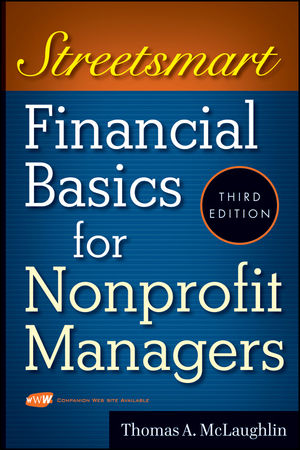Streetsmart Financial Basics for Nonprofit Managers, 3rd EditionISBN: 978-0-470-41499-6
Paperback
280 pages
April 2009
 This title is out-of-print and not currently available for purchase from this site.
|
Note to Reader.
PART ONE ANALYSIS.
CHAPTER 1 Organizational Structure: Programs and Corporations.
Types of Nonprofit Organizations.
Structure of Nonprofit Organizations.
Loss of Tax-Exempt Status—The Monster Within.
CHAPTER 2 Mission: Managing Your Two Bottom Lines.
The Role of a Value System.
The Nonprofit’s Dilemma and How to Solve It.
CHAPTER 3 Accounting as a Second Language—A Nine-Point Program.
The Entity Principle.
Money Measurement.
Conservatism Principle.
The Cost Concept.
The Materiality Principle.
Going Concern.
Dual Aspect.
Realization Principle.
Matching Principle.
CHAPTER 4 Assets Are for Boards, Activities Are for Managers.
Concepts versus Details.
Boards Invest, Managers Spend.
If It Has to Be Decided Today, It’s Probably the Wrong Question.
Boards Own the Controls, Managers Implement Them.
CHAPTER 5 Balance Sheets: How They Get That Way.
Current Assets.
Noncurrent Assets.
Current Liabilities.
Noncurrent Liabilities.
Making the Balance Sheet Dance.
Transparency, Thy Name Is IRS Form 990.
Sweeping Change.
What to Do.
CHAPTER 6 Financial Analysis: A Few Diagnostic Tools.
Financial Statement Analysis for Math Phobics.
Current Ratio.
Days’ Cash.
Days’ Receivables.
Cash Flow to Total Debt.
Debt to Net Assets.
Total Margin.
Operating Margin.
Accounting Age of Plant/Equipment (or Land, Buildings, and Equipment).
A Footnote.
PART TWO ACCOUNTING.
CHAPTER 7 Nonprofit Accounting: Acknowledging the Strings Attached.
Net Asset Categories.
Other Provisions.
What It All Means.
CHAPTER 8 Cost Accounting: How Much Does It Cost?
A Form of Management Accounting.
Indirect Costs.
Certain Support Costs Get Assigned to Other Support Costs.
Breakeven Analysis—Another Use for Cost Data.
Cost Accounting versus Cost Reporting.
CHAPTER 9 Auditing: Choosing and Using an Auditor.
Audit, Review, and Compilation.
The Auditor Market.
Getting Value from the Audit.
Conclusion.
PART THREE OPERATIONS.
CHAPTER 10 Cash Flow Management: Why Cash Is King.
Up the Balance Sheet.
How Much Cash Is Enough?
Conclusion.
CHAPTER 11 Capital: Why Capital Is Not a Four-Letter Word.
The Mechanics of Capital Financing.
The Present Value of Money.
Sources of Capital.
The Great Divide among Nonprofits.
Future Access to Capital Markets.
The Role of Net Assets.
Strategic Capital Management.
CHAPTER 12 Budgeting: Taming the Budget Beast.
Playing Revenues Like a Symphony.
Expenses.
Indirect (General and Administrative) Costs.
Conclusion.
CHAPTER 13 Indirect Costs and Other Despised Items.
Still, It’s Low That Counts.
Secret of the Indirect Cost Game.
CHAPTER 14 Pricing: How Much Should It Cost?
Pricing Methodologies.
Going the Other Way—Contractual Adjustments and Subsidies.
Pricing Strategies.
How to Price.
CHAPTER 15 Profit: Why and How Much?
Profit Defined.
Uses of Profit.
Profit—How to Get It.
What Can Be Done.
CHAPTER 16 To Raise More Money, Think Cows.
Donations.
Bequests—Cow to Charity.
Charitable Remainder Trusts—Milk to Beneficiaries, Cow to Charity.
Pooled Income Funds—Donors Put Their Cows in a Herd, Keep Rights to Milk.
CHAPTER 17 Insurance: The Maddeningly Complicated Art of Covering Your Assets.
To Insure or Self-Insure?
Risk Management.
CHAPTER 18 Internal Controls for External Goals.
The Elements of Internal Control.
How to Monitor the System.
Maintaining the System.
Conclusion.
CHAPTER 19 Enron Spawn.
Some Predictions.
The New Industry of Charity Watching.
CHAPTER 20 Management Controls: Toward Accountability for Performance.
Management Controls Circa 1980.
Beyond Management Controls in the Twenty-First Century: How to Do It.
Messages.
How to Prepare—The CFO of the Future.
Appendix A A Financial Management Cultural Primer.
Appendix B Budget Bloopers.
Appendix C Using the Web Site.
Index.



